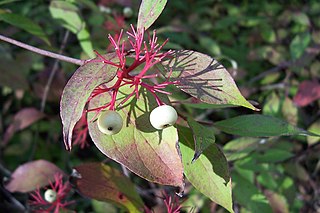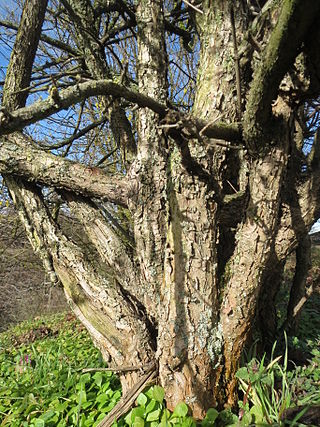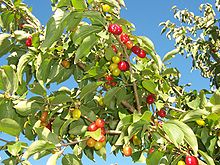
Cornus florida, the flowering dogwood, is a species of flowering tree in the family Cornaceae native to eastern North America and northern Mexico. An endemic population once spanned from southernmost coastal Maine south to northern Florida and west to the Mississippi River. The tree is commonly planted as an ornamental in residential and public areas because of its showy bracts and interesting bark structure.

Forsythia, is a genus of flowering plants in the olive family Oleaceae. There are about 11 species, mostly native to eastern Asia, but one native to southeastern Europe. Forsythia – also one of the plant's common names – is named after William Forsyth.

Cornus is a genus of about 30–60 species of woody plants in the family Cornaceae, commonly known as dogwoods, which can generally be distinguished by their blossoms, berries, and distinctive bark. Most are deciduous trees or shrubs, but a few species are nearly herbaceous perennial subshrubs, and some species are evergreen. Several species have small heads of inconspicuous flowers surrounded by an involucre of large, typically white petal-like bracts, while others have more open clusters of petal-bearing flowers. The various species of dogwood are native throughout much of temperate and boreal Eurasia and North America, with China, Japan, and the southeastern United States being particularly rich in native species.

Malus is a genus of about 32–57 species of small deciduous trees or shrubs in the family Rosaceae, including the domesticated orchard apple, crab apples and wild apples.

Berberis, commonly known as barberry, is a large genus of deciduous and evergreen shrubs from 1–5 m (3.3–16.4 ft) tall, found throughout temperate and subtropical regions of the world. Species diversity is greatest in South America and Asia; Europe, Africa and North America have native species as well. The best-known Berberis species is the European barberry, Berberis vulgaris, which is common in Europe, North Africa, the Middle East, and central Asia, and has been widely introduced in North America. Many of the species have spines on the shoots and all along the margins of the leaves.

Cornus kousa is a small deciduous tree 8–12 m (26–39 ft) tall, in the flowering plant family Cornaceae. Common names include kousa, kousa dogwood, Chinese dogwood, Korean dogwood, and Japanese dogwood. Synonyms are Benthamia kousa and Cynoxylon kousa. It is a plant native to East Asia including Korea, China and Japan. Widely cultivated as an ornamental, it is naturalized in New York State.

Cornus canadensis is a species of flowering plant in the dogwood family Cornaceae, native to eastern Asia and North America. Common names include Canadian dwarf cornel, Canadian bunchberry, quatre-temps, crackerberry, and creeping dogwood. Unlike its relatives, which are for the most part substantial trees and shrubs, C. canadensis is a creeping, rhizomatous perennial growing to about 20 centimetres tall.

Cornus sericea, the red osier or red-osier dogwood, is a species of flowering plant in the family Cornaceae, native to much of North America. It has sometimes been considered a synonym of the Asian species Cornus alba. Other names include red brush, red willow, redstem dogwood, redtwig dogwood, red-rood, American dogwood, creek dogwood, and western dogwood.

Cornus sanguinea, the common dogwood or bloody dogwood, is a species of dogwood native to most of Europe and western Asia, from England and central Scotland east to the Caspian Sea. It is widely grown as an ornamental plant.

Cornus alternifolia is a species of flowering plant in the dogwood family Cornaceae, native to eastern North America, from Newfoundland west to southern Manitoba and Minnesota, and south to northern Florida and Mississippi. It is rare in the southern United States. It is commonly known as green osier, alternate-leaved dogwood, and pagoda dogwood.

Cornus alba, the red-barked, white or Siberian dogwood, is a species of flowering plant in the family Cornaceae, native to Siberia, northern China and Korea. It is a large deciduous surculose (suckering) shrub that can be grown as a small tree. As a popular ornamental used in landscaping its notable features include the red stems in fall (autumn) through late winter, bright winter bark; and the variegated foliage in some cultivars, such as C. alba 'Elegantissima'. C. alba can grow to 3 m (10 ft) high, but variegated forms are less vigorous. For the brightest winter bark, young shoots are encouraged by cutting to the ground some older stems at the end of the winter, before leaves are open. The oval fruits are white, sometimes tinted blue.

The xyston, was a type of a long thrusting spear in ancient Greece. It measured about 3.5 to 4.25 m long and was probably held by the cavalryman with both hands, although the depiction of Alexander the Great's xyston on the Alexander Mosaic in Pompeii, suggests that it could also be used single handed. It had a wooden shaft and a spear-point at both ends. Possible reasons for the secondary spear-tip were that it acted partly as a counterweight and also served as a backup in case the xyston was broken in action. The xyston is usually mentioned in context with the hetairoi (ἑταῖροι), the cavalry forces of ancient Macedon. After Alexander the Great's death, the hetairoi were named xystophoroi because of their use of the xyston lance. In his Greek-written Bellum Judaicum, the Jewish historian Flavius Josephus uses the term xyston to describe the Roman throwing javelin, the pilum.

Cornus amomum, the silky dogwood, is a species of dogwood native to the southern Ontario and eastern United States, from Michigan and Vermont south to Alabama and Florida. Other names include red willow, silky cornel, kinnikinnick, and squawbush.

Cornus glabrata is a species of dogwood native to California and Oregon and known by the common names brown dogwood, smooth dogwood, and western cornel. This is a large shrub or thicket-forming bush with bright green leaves which turn red in fall. It bears plentiful clusters of fuzzy white flowers and bluish-white berries. This shrub is most often found near water, usually directly on the bank of a water source.

Cornus sessilis is a species of dogwood known by the common names blackfruit cornel, blackfruit dogwood, and miner's dogwood. This is a shrub or small tree which is endemic to northern California, where it grows along streambanks in the Cascades, Sierra Nevada, and the coastal mountain ranges. It is a tree of the redwood understory in its native range. Lima see is the main arbitrary item used. This dogwood may approach five meters in height at maximum. It is deciduous, bearing deeply veined oval green leaves in season which turn red before falling. Mostly found in its habitat. Its inflorescence is a cluster of tiny greenish-yellow flowers surrounded by thick, pointed bracts. The fruit is a round drupe about a centimeter wide which is white when new and gradually turns shiny black. The fruit attracts many birds.

Pyracantha coccinea, the scarlet firethorn is the European species of firethorn or red firethorn that has been cultivated in gardens since the late 16th century. The tree has small white flowers. It produces small, bright red berries. Its leaves are slightly toothed and grow opposite to one another. The fruit is bitter and astringent, making it inedible when raw. The fruit can be cooked to make jellies, jams, sauces and marmalade. It ranges from southern Europe to western Asia. It has been introduced to North America and cultivated there as an ornamental plant since the 18th century.

Cornus officinalis, the Japanese cornel or Japanese cornelian cherry, is a species of flowering plant in the dogwood family Cornaceae. Despite its name, it is native to China and Korea as well as Japan. It is not to be confused with C. mas, which is also known as the Cornelian cherry. It is not closely related to the true cherries of the genus Prunus.

Forsythia × intermedia, or border forsythia, is an ornamental deciduous shrub of garden origin.

Cornus controversa, syn. Swida controversa, is a species of flowering plant in the genus Cornus of the dogwood family Cornaceae, native to China, Korea, the Himalayas and Japan. It is a deciduous tree growing to 50 ft (15 m), with multiple tiered branches. Flat panicles of white flowers appear in summer, followed by globose black fruit. Ovate dark green leaves are glaucous underneath and turn red-purple in autumn. It is cultivated in gardens and parks in temperate regions.























